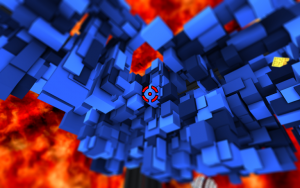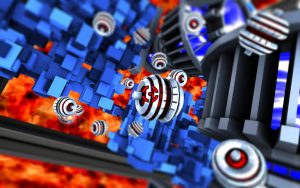Over the past few weeks you might have seen VRFocus cover an intriguing new virtual reality (VR) title by the name of Caretaker. This new project from Byron Atkinson-Jones of Xiotex Studios looks to combine exploration, puzzle and stealth gameplay into a unique experience in which players will progress through the surreal architecture of an alien structure. VRFocus recently spoke to Atikson-Jones himself about the project.
In the interview below the developer describes the title’s setup, its support for the Oculus Rift head-mounted display (HMD) and more. Stay tuned to VRFocus for the latest on Caretaker as it heads towards its Q1 2016 release.
VRFocus: Explain the setup of Caretaker and how players will interact with the title.
Byron Atkinson-Jones (BAJ): You wake up from suspended animation in a vast alien structure. Everyone else in the universe is dead, killed by this structure. You have a mission that will decide the fate of reality itself and to succeed you have to locate a series of artefacts. It’s not an easy task though, the structure is unlike anything you will have encountered before which means you have to explore it. Exploration is dangerous as the structure has a number of automated defence systems in place that will attempt to destroy you. You have to try and make your way past them without alerting them to your presence, if you do they will attempt to hunt you down and stop you.
The environment itself will present you with physical challenges to progress. An example is a demo level people played at MCM Comicon. In this level there’s a massive turbine fan blocking your progress, if you touch the spinning fan it means instant death, you have to find a way to disable the fan to go on.
Caretaker is divided into three ‘acts.’ Each act has a distinct look and feel and requires a different way to play it. Each of course gets progressively harder to play as you go along. All the way through in the background will be the voice of David Hewlett letting you know why you are there and what your objective is.
VRFocus: Would you describe this project as a Six-Degree-Of-Freedom shooter? The genre has been making a comeback recently with the help of VR.
BAJ: It’s true that Caretaker has a six-degree-of-freedom type controls but that’s as far as the comparison goes. It’s not a fast-paced arcade game – more of an adventure game with stealth and puzzle elements. There is shooting of a sorts but it’s a weapon of last resort to be used when all other methods fail as it exacts a great cost.
VRFocus: You mention a ‘great cost’ to engaging in combat. How does combat play out in the title and what do players put at risk?
BAJ: I was pretty insistent that there shouldn’t be any combat in Caretaker from the beginning, Being able to just shoot yourself out of a situation is just too easy a game design crutch to fall on. However, as the design progressed I realised that the primary method of interacting with the environment (and solving puzzles) in Caretaker could also be used as an offensive weapon. It should be used sparingly though and one way I ensure that is to make it a weapon of last resort as it gobbles up your energy, and if you use up all your energy you die. This means that using your energy as a weapon is a strategic choice, but to do so could mean you don’t have any left to complete the rest of the objectives of the level. It’s entirely up to you the player.
VRFocus: Can you talk about how you went about designing Caretaker‘s environments? As you mention they’re unlike anything we’ve seen before.
BAJ: The structure you start off in in Caretaker is an alien device. It’s not meant to be like anything you’ve encountered before and in context of the game it was grown rather than designed.
In practical terms this means me doodling in a 3D art package called Modo where I start off with a list of objectives and then kind of grow the level around them to provide a challenge to the player going through the environment. This is done in block form and once those blocks have been finished I run the entire mesh through a custom Modo plugin I wrote that turns it into the kind of blue random-looking structures you’ve seen so far in the screenshots.
Those blocks only represent the first act of Caretaker, the other two acts look visually different and they also are more structured and less random than the first. People who completed the first level of the Caretaker demo at Comicon got to experience a single level of the second act.
VRFocus: How did the collaboration with David Hewlett come about? What role does he play in the experience?
BAJ: How this came about is a story of incredible odds and unbelievable coincidence.
While I was developing the early versions of Caretaker I had Stargate Atlantis running back to back on Netflix in the background as I coded the game. My favourite character was always Dr Rodney McKay and it was his voice that I imagined as the narrator as I was building Caretaker. It was never going to happen though – how the heck could somebody like me get in contact with an actor like David Hewlett, let alone convince them to be a part of my game?
Wind on a couple of months and I’m finally ready to show people a live demo of Caretaker. The first person I show it to is Stewart Gilray. He plays it and then comes back with feedback. The first was that the demo I showed him reminded him a lot of a film called Cube and he had a friend who starred in it. My ears prick up because David Hewlett, the actor I had in mind for the narrator of Caretaker starred in Cube. Sure enough, Stewart’s friend turns out to be David Hewlett and not only that he offers to introduce me to him. I still can’t get over that – the very first person I show Caretaker to happens to be friends with the actor I want to be in Caretaker. The odds of that are incredible.
Stewart does an introduction via email and I pitched the plot of Caretaker to David and before I know it he’s on board.
The part that David plays is one of somebody who is long dead. You (the player) have been in suspended animation for a very long time – possibly thousands or millions of years. Everyone else is dead and you are completely alone and in the alien structure that was the cause of the end of the universe. You have a mission to complete but given how long you’ve been under your mind is scrambled so David’s character tells you the story of what happened bit by bit so that your memory returns and you can complete the mission. Or is there another agenda at work?
You’ll have to play Caretaker to find out more 
VRFocus: Why did you decide to add VR support and for how long as it been a part of the project?
BAJ: From the start it was clear to me that Caretaker would be a good VR game. The problem was lack of access to any VR hardware. Eventually I sent a demo of Caretaker to Oculus and the next thing I know there’s a delivery note telling me that part 1 of a multi-part order would be arriving at my door in a few days’ time. It turns out Oculus played Caretaker and assumed a team of people were making it so they were sending a load of DK2’s to us. I managed to get hold of them in time to say it was just me but I got home one night to a tower of DK2’s by my front door – the first part of the delivery was four DK2’s. I often wonder how many I would have ended up with had I not got in touch to say it was just me developing Caretaker. Oculus were incredibly nice and said I should just keep the four DK2’s and I’m glad they did as it’s this that’s allowed me to show Caretaker on more than one PC at MCM Comicon.
VRFocus: Are you considering support for other VR head-mounted displays such as the HTC Vive and, if possible, a PlayStation 4 port with PlayStation VR support?
BAJ: I’d love to support more VR devices – it really comes down to that I only have a few DK2’s. I signed up for the Developer version of the Vive but never heard anything  The Playstation VR would be a good candidate but again I’d have to be a Playstation developer for that to happen and I’m not at the moment.
The Playstation VR would be a good candidate but again I’d have to be a Playstation developer for that to happen and I’m not at the moment.
VRFocus: Caretaker recently debuted at MCM Comic Con, what was on show and how was the response?
BAJ: MCM Comicon was incredible. Whenever somebody tells you that their show will have at least 120,000 people turn up you kind of think it’s just a sales pitch and then it actually happens. I totally under-estimated how popular the game would be during the three days we were there. I had two PC’s setup connected to 50” screens and a DK2 each. There was a constant queue all weekend to play Caretaker. We even had a queue before the doors opened each day as other vendors at the show would come over to play it. At one point we were blocking the two stands next to us due to sheer weight of numbers waiting to have a go. We restricted the demo to three minutes – longer if they completed the first level and got through to the second but that happened very infrequently so in the end with a three minute demo and a 1-2 minute setup time for the next person we calculated that over 648 people played Caretaker.
That still blows my mind – 648 people! That just never happens for an indie game at a show. It’s something amazing to see a queue 35 people deep waiting to play your game.
Some odd things happened. The first was that somebody asked me for my autograph, which has never happened before and I suddenly had an attack of imposter syndrome. The second was somebody offered us £200 to skip to the head of the queue to play Caretaker and the last was we had a visit from the police – apparently a little boy had gone missing. He had said that Caretaker was his favourite game of the show so they thought he would be with us. Thankfully we heard that they eventually found him.
-END-
The post Caretaker Dev Talks VR Support, Story and More appeared first on VRFocus.

















